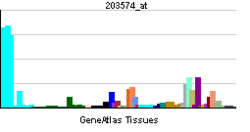NFIL3
| View/Edit Human | View/Edit Mouse |
Nuclear factor, interleukin 3 regulated, also known as NFIL3 or E4BP4 is a protein which in humans is encoded by the NFIL3 gene.[3]
Function
Expression of interleukin-3 (IL3) is restricted to activated T cells, natural killer (NK) cells, and mast cell lines. Transcription initiation depends on the activating capacity of specific protein factors, such as NFIL3, that bind to regulatory regions of the gene, usually upstream of the transcription start site.[3][4]
References
- ↑ "Human PubMed Reference:".
- ↑ "Mouse PubMed Reference:".
- 1 2 "Entrez Gene: NFIL3 nuclear factor, interleukin 3 regulated".
- ↑ Zhang W, Zhang J, Kornuc M, Kwan K, Frank R, Nimer SD (November 1995). "Molecular cloning and characterization of NF-IL3A, a transcriptional activator of the human interleukin-3 promoter". Mol. Cell. Biol. 15 (11): 6055–63. PMC 230857
 . PMID 7565758.
. PMID 7565758.
Further reading
- Cowell IG, Skinner A, Hurst HC (1992). "Transcriptional repression by a novel member of the bZIP family of transcription factors.". Mol. Cell. Biol. 12 (7): 3070–7. PMC 364521
 . PMID 1620116.
. PMID 1620116. - Zhang W, Zhang J, Kornuc M, et al. (1995). "Molecular cloning and characterization of NF-IL3A, a transcriptional activator of the human interleukin-3 promoter.". Mol. Cell. Biol. 15 (11): 6055–63. PMC 230857
 . PMID 7565758.
. PMID 7565758. - Matoba R, Okubo K, Hori N, et al. (1994). "The addition of 5'-coding information to a 3'-directed cDNA library improves analysis of gene expression.". Gene. 146 (2): 199–207. doi:10.1016/0378-1119(94)90293-3. PMID 8076819.
- Cowell IG, Hurst HC (1996). "Protein–protein interaction between the transcriptional repressor E4BP4 and the TBP-binding protein Dr1.". Nucleic Acids Res. 24 (18): 3607–13. doi:10.1093/nar/24.18.3607. PMC 146135
 . PMID 8836190.
. PMID 8836190. - Ikushima S, Inukai T, Inaba T, et al. (1997). "Pivotal role for the NFIL3/E4BP4 transcription factor in interleukin 3-mediated survival of pro-B lymphocytes.". Proc. Natl. Acad. Sci. U.S.A. 94 (6): 2609–14. doi:10.1073/pnas.94.6.2609. PMC 20136
 . PMID 9122243.
. PMID 9122243. - Hulme DJ, Blair IP, Dawkins JL, Nicholson GA (2000). "Exclusion of NFIL3 as the gene causing hereditary sensory neuropathy type I by mutation analysis.". Hum. Genet. 106 (6): 594–6. doi:10.1007/s004390050030. PMID 10942106.
- Strausberg RL, Feingold EA, Grouse LH, et al. (2003). "Generation and initial analysis of more than 15,000 full-length human and mouse cDNA sequences.". Proc. Natl. Acad. Sci. U.S.A. 99 (26): 16899–903. doi:10.1073/pnas.242603899. PMC 139241
 . PMID 12477932.
. PMID 12477932. - Ozkurt IC, Tetradis S (2003). "Parathyroid hormone-induced E4BP4/NFIL3 down-regulates transcription in osteoblasts.". J. Biol. Chem. 278 (29): 26803–9. doi:10.1074/jbc.M212652200. PMID 12743120.
- Rual JF, Venkatesan K, Hao T, et al. (2005). "Towards a proteome-scale map of the human protein–protein interaction network.". Nature. 437 (7062): 1173–8. doi:10.1038/nature04209. PMID 16189514.
- Priceman SJ, Kirzner JD, Nary LJ, et al. (2006). "Calcium-dependent upregulation of E4BP4 expression correlates with glucocorticoid-evoked apoptosis of human leukemic CEM cells.". Biochem. Biophys. Res. Commun. 344 (2): 491–9. doi:10.1016/j.bbrc.2006.03.169. PMC 2763529
 . PMID 16630563.
. PMID 16630563.
This article incorporates text from the United States National Library of Medicine, which is in the public domain.
This article is issued from Wikipedia - version of the 6/3/2016. The text is available under the Creative Commons Attribution/Share Alike but additional terms may apply for the media files.
